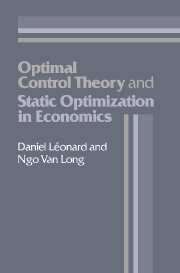Book contents
- Frontmatter
- Contents
- Preface
- 1 Static optimization
- 2 Ordinary differential equations
- 3 Introduction to dynamic optimization
- 4 The maximum principle
- 5 The calculus of variations and dynamic programming
- 6 The general constrained control problem
- 7 Endpoint constraints and transversality conditions
- 8 Discontinuities in the optimal controls
- 9 Infinite-horizon problems
- 10 Three special topics
- Bibliography
- Index
8 - Discontinuities in the optimal controls
Published online by Cambridge University Press: 05 June 2012
- Frontmatter
- Contents
- Preface
- 1 Static optimization
- 2 Ordinary differential equations
- 3 Introduction to dynamic optimization
- 4 The maximum principle
- 5 The calculus of variations and dynamic programming
- 6 The general constrained control problem
- 7 Endpoint constraints and transversality conditions
- 8 Discontinuities in the optimal controls
- 9 Infinite-horizon problems
- 10 Three special topics
- Bibliography
- Index
Summary
It was stated at the end of Chapter 4 and again in Section 6.1 that control variables are required only to be piecewise-continuous. This means that they can exhibit jump discontinuities at a finite number of dates along the horizon. These discontinuities in the control may in turn result in discontinuities for the time derivatives of the state and costate variables, but the state and costate variables are themselves piecewise-differentiate (i.e., there may exist a finite number of points where the left- and righthand- side derivatives differ from one another). We claimed that this feature greatly enlarged the variety of problems that optimal control theory could handle and proved our point with a simple example in Section 6.1. In electrical engineering such discontinuities result in the operation of various circuit switches; in economics this takes the form of policy switches.
In the examples studied so far we have restricted the Hamiltonian to be strictly concave in the controls and the optimal trajectories have been continuous. Difficulties arise when we deal with problems that are linear in the controls (or can be made so), at least over some ranges; in these cases there are often bounds on the control variables, either imposed exogenously or generated endogenously. Except for a few theorems on timeoptimal problems (see Pontryagin, 1962, pp. 120–4), there are no general results for dealing with these problems, so we have chosen to illustrate them with various examples.
- Type
- Chapter
- Information
- Optimal Control Theory and Static Optimization in Economics , pp. 263 - 284Publisher: Cambridge University PressPrint publication year: 1992



